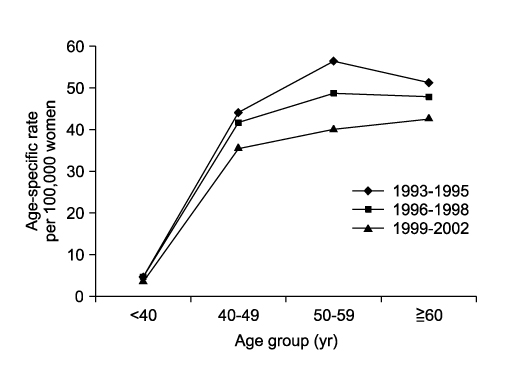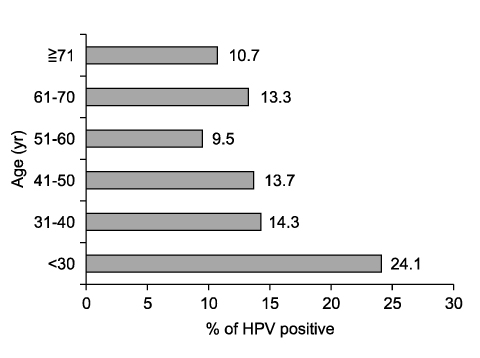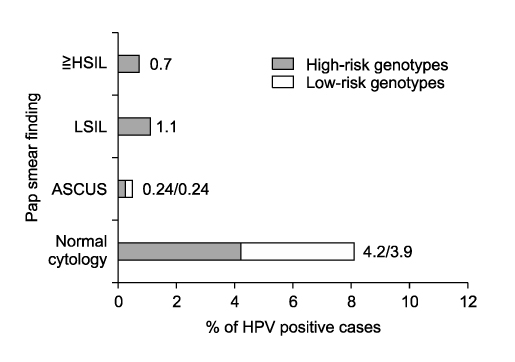Current status of cervical cancer and HPV infection in Korea
- Affiliations
-
- 1Department of Obstetrics and Gynecology, College of Medicine, University of Ulsan, Asan Medical Center, Seoul, Korea. ytkim@amc.seoul.kr
- KMID: 2055640
- DOI: http://doi.org/10.3802/jgo.2009.20.1.1
Abstract
- Cervical cancer is an important cause of cancer-related deaths in women in developing countries. In Korea, cervical cancer is the third leading cancer among females and is fifth highest in mortality. The persistent oncogenic human papillomavirus (HPV) infections are the greatest risk of developing cervical intraepithelial neoplasia and invasive cancer. The overall prevalence of HPV was 10.4% in Korea and strong risk factors for HPV infection included a young age at sexual debut. The National Cancer Screening Program, which includes cervical cancer screening, has the following principles: the main screening tool is the Papanicolaou test conducted by gynecologists, which targets all women age 30 and over, and which is done every 2 years. HPV DNA tests have not yet been permitted as a screening test for cervical cancer in Korea; however, these are conducted along with a Pap test for screening cervical cancer in the clinic. The use of prophylactic HPV vaccine has been accepted in Korea; The Korean Society of Gynecologic Oncology and Colposcopy's recommendation for routine vaccination is for females aged 15-17 years with a catch-up vaccination recommended for females aged 18-26 years who have not been previously vaccinated. However, many people in Korea are not familiar with the HPV vaccine. Therefore, it is necessary to improve awareness for the disease and HPV vaccination and to establish the effective strategies to obtain funding for HPV vaccination. In the future, cervical cancer is expected to disappear throughout the world, including the Asia Pacific region, through a combination of vaccination and qualified screening programs for cervical cancer.
MeSH Terms
Figure
Cited by 5 articles
-
The incidence and survival of cervical, ovarian, and endometrial cancer in Korea, 1999-2017: Korea Central Cancer Registry
Hyeong In Ha, Ha Kyun Chang, Soo Jin Park, Jiwon Lim, Young-Joo Won, Myong Cheol Lim
Obstet Gynecol Sci. 2021;64(5):444-453. doi: 10.5468/ogs.21116.Prevalence and Genotype of Human Papillomavirus Infection and Risk of Cervical Dysplasia among Asymptomatic Korean Women
Soie Chung, Sue Shin, Jong Hyun Yoon, Eun Youn Roh, Sung Jun Seoung, Gyoung Pyoung Kim, Eui-Chong Kim
Ann Clin Microbiol. 2013;16(2):87-91. doi: 10.5145/ACM.2013.16.2.87.Factors Associated with Human Papillomavirus Vaccination and Intention among Male and Female College Students
Seung Yeun Lee, Mi Ah Han, Jong Park, So Yeon Ryu
Korean J Health Promot. 2015;15(3):141-149. doi: 10.15384/kjhp.2015.15.3.141.Trends and Age-Period-Cohort Effects on the Incidence and Mortality Rate of Cervical Cancer in Korea
Eun-Kyeong Moon, Chang-Mo Oh, Young-Joo Won, Jong-Keun Lee, Kyu-Won Jung, Hyunsoon Cho, Jae Kwan Jun, Myong Cheol Lim, Moran Ki
Cancer Res Treat. 2017;49(2):526-533. doi: 10.4143/crt.2016.316.Incidence and survival of gynecologic cancer including cervical, uterine, ovarian, vaginal, vulvar cancer and gestational trophoblastic neoplasia in Korea, 1999–2019: Korea Central Cancer Registry
Bo Seong Yun, Eun Hye Park, Johyun Ha, Jung-Yun Lee, Keun Ho Lee, Taek Sang Lee, Kyung Ju Lee, Young Ju Kim, Kyu-Won Jung, Ju-Won Roh
Obstet Gynecol Sci. 2023;66(6):545-561. doi: 10.5468/ogs.23208.
Reference
-
1. De Villiers EM, Fauquet C, Broker TR, Bernard HU, Zur Hausen H. Classification of papillomaviruses. Virology. 2004. 324:17–27.2. Munoz N, Bosch FX, de Sanjose S, Herrero R, Castellsague X, Shah KV, et al. Epidemiologic classification of human papillomavirus types associated with cervical cancer. N Engl J Med. 2003. 348:518–527.3. Lacey CJ. Therapy for genital human papillomavirus-related disease. J Clin Virol. 2005. 32:Suppl 1. S82–S90.4. Miller BA, Kolonel LN, Bernstein L, Young JL, Swanson GM, West D, editors. Racial/ethnic patterns of cancer in the United States 1988-1992. 1996. Bethesda, MD: National Cancer Institute.5. Freeman HP, Wingrove BK. Excess cervical cancer mortality: a marker for low access to health care in poor communities. 2005. Rockville, MD: National Cancer Institute.6. Parkin DM, Whelan SL, Ferlay J, Teppo L, Thomas DB, editors. Cancer incidence in five continents. 2002. vol. VIII. Lyon: IARC.7. Behbakht K, Lynch A, Teal S, Degeest K, Massad S. Social and cultural barriers to Papanicolaou test screening in an urban population. Obstet Gynecol. 2004. 104:1355–1361.8. Cooper CP, Saraiya M, McLean TA, Hannan J, Liesmann JM, Rose SW, et al. Report from the CDC. Pap test intervals used by physicians serving low-income women through the National Breast and Cervical Cancer Early Detection Program. J Womens Health (Larchmt). 2005. 14:670–678.9. Chung HH, Jang MJ, Jung KW, Won YJ, Shin HR, Kim JW, et al. Cervical cancer incidence and survival in Korea: 1993-2002. Int J Gynecol Cancer. 2006. 16:1833–1838.10. Shin HR, Jung KW, Won YJ, Kong HJ, Yim SH, Sung J, et al. National cancer incidence for the year 2002 in Korea. Cancer Res Treat. 2007. 39:139–149.11. Curado MP, Edwards B, Shin HR, Storm H, Feray J, Heanue M, et al. IARC Scientific Publications No. 160. Cancer incidence in five continents. 2007. Volume IX. Lyon: IARC.12. Shin HR, Park S, Hwang SY, Kim JE, Jung KW, Won YJ, et al. Trends in cervical cancer mortality in Korea 1993-2002: corrected mortality using national death certification data and national cancer incidence data. Int J Cancer. 2008. 122:393–397.13. Jung KW, Yim SH, Kong HJ, Hwang SY, Won YJ, Lee JK, et al. Cancer survival in Korea 1993-2002: a population-based study. J Korean Med Sci. 2007. 22:Suppl. S5–S10.14. Joo WD, Kim SH, Kim DY, Suh DS, Kim JH, Kim YM, et al. Prevalence of human papillomavirus infection in Korean women: risks of abnormal Pap smear and cervical neoplasia. Korean J Gynecol Oncol Colposc. 2004. 15:309–316.15. Shin HR, Lee DH, Herrero R, Smith JS, Vaccarella S, Hong SH, et al. Prevalence of human papilloma virus infection in women in Busan, South Korea. Int J Cancer. 2003. 103:413–421.16. Hwang T. Detection and typing of human papillomavirus DNA by PCR using consensus primers in various cervical lesions of Korean women. J Korean Med Sci. 1999. 14:593–599.17. An HJ, Cho NH, Lee SY, Kim IH, Lee C, Kim SJ, et al. Correlation of cervical carcinoma and precancerous lesions with human papillomavirus (HPV) genotypes detected with the HPV DNA chip microarray method. Cancer. 2003. 97:1672–1680.18. Cho NH, An HJ, Jeong JK, Kang S, Kim JW, Kim YT, et al. Genotyping of 22 human papillomavirus types by DNA chip in Korean women: comparison with cytologic diagnosis. Am J Obstet Gynecol. 2003. 188:56–62.19. Hwang TS, Jeong JK, Park M, Han HS, Choi HK, Park TS. Detection and typing of HPV genotypes in various cervical lesions by HPV oligonucleotide microarray. Gynecol Oncol. 2003. 90:51–56.20. Kim YB, Jeon YT, Seo SS, Kim JW, Park NH, Song YS, et al. Prevalence and genotyping of HPV in cervical cancer of Korean women. Korean J Obstet Gynecol. 2003. 46:789–794.21. Park HK, Kang YM, Park JM, Choi YJ, Kim YN, Jeong DH, et al. Cervical intraepithelial neoplasia and cervical cancer. Korean J Gynecol Oncol Colposc. 2003. 14:123–132.22. Park TC, Kim CJ, Koh YM, Lee KH, Yoon JH, Kim JH, et al. Human papillomavirus genotyping by the DNA chip in the cervical neoplasia. DNA Cell Biol. 2004. 23:119–125.23. An HJ, Kim KR, Kim IS, Kim DW, Park MH, Park IA, et al. Prevalence of human papillomavirus DNA in various histological subtypes of cervical adenocarcinoma: a population-based study. Mod Pathol. 2005. 18:528–534.24. Wui JH, Seong HJ, Lee TS, Oh HK, Park KK, Choi YS. The distribution of HPV subtype and multiple HPV infection in cervical cancer and precancerous lesion. Korean J Gynecol Oncol. 2006. 17:39–46.25. Lee JH, Lee KH, Lee IH, Woo HJ, Seong SJ, Kim TJ, et al. Genotyping of human papillomavirus detected with the HPV DNA chip in cervical cancer. Korean J Obstet Gynecol. 2006. 49:858–865.26. Lee HS, Kim KM, Kim SM, Choi YD, Nam JH, Park CS, et al. Human papillomavirus genotyping using HPV DNA chip analysis in Korean women. Int J Gynecol Cancer. 2007. 17:497–501.27. Bae JH, Lee SJ, Kim CJ, Hur SY, Park YG, Lee WC, et al. Human papillomavirus (HPV) type distribution in Korean women: a meta-analysis. J Microbiol Biotechnol. 2008. 18:788–794.28. Shin HR, Franceschi S, Vaccarella S, Roh JW, Ju YH, Oh JK, et al. Prevalence and determinants of genital infection with papillomavirus, in female and male university students in Busan, South Korea. J Infect Dis. 2004. 190:468–476.29. Oh JK, Franceschi S, Kim BK, Kim JY, Ju YH, Hong EK, et al. Prevalence of human papillomavirus and Chlamydia trachomatis infection among women attending cervical cancer screening in the Republic of Korea. Eur J Cancer Prev. 2009. 18:56–61.30. Korean Center for Disease Control and Prevention. Second online survey for the health behavioral factors among adolescents in Korea in 2006. 2006. Seoul: Korea Center for Disease Control and Prevention.31. Koo HW, Yoo KY, Kim DH, Song YS, Park NH, Kang SB, et al. A case-control study on risk factors of uterine cervix cancer in Korea. Korean J Prev Med. 1996. 29:159–172.32. The Ministry of Health and Welfare. The first Korean national health and nutrition examination survey. 1998. Seoul: Korea Center for Disease Control.33. The Ministry of Health and Welfare. The second Korean national health and nutrition examination survey. 2001. Seoul: Korea Center for Disease Control and Prevention.34. The Ministry of Health and Welfare. The third Korean national health and nutrition examination survey. 2005. Seoul: Korea Center for Disease Control.35. Nanda K, McCrory DC, Myers ER, Bastian LA, Hasselblad V, Hickey JD, et al. Accuracy of the Papanicolaou test in screening for and follow-up of cervical cytologic abnormalities: a systematic review. Ann Intern Med. 2000. 132:810–819.36. Shin JH, Lee JK, Chough SY, Hur JY, Park YK, Saw HS. Hybrid capture system HPV DNA test as a screening tool of cervical cancer. Korean J Gynecol Oncol Colposc. 2001. 12:31–38.37. Kim SJ, Park CK, Lee HP, Namkoong SE, Kang SB, Saw HS, et al. Multiinstitutional study for the development of cervical cancer screening model with new cervicography, pap smear and HPV-DNA test. Korean J Obstet Gynecol. 2001. 44:911–937.38. Bernstein SJ, Sanchez-Ramos L, Ndubisi B. Liquid-based cervical cytologic smear study and conventional Papanicolaou smears: a meta-analysis of prospective studies comparing cytologic diagnosis and sample adequacy. Am J Obstet Gynecol. 2001. 185:308–317.39. Schiffman M, Herrero R, Hildesheim A, Sherman ME, Bratti M, Wacholder S, et al. HPV DNA testing in cervical cancer screening: results from women in a high-risk province of Costa Rica. JAMA. 2000. 283:87–93.40. Wright TC Jr, Denny L, Kuhn L, Pollack A, Lorincz A. HPV DNA testing of self-collected vaginal samples compared with cytologic screening to detect cervical cancer. JAMA. 2000. 283:81–86.41. Womack SD, Chirenje ZM, Gaffikin L, Blumenthal PD, McGrath JA, Chipato T, et al. HPV-based cervical cancer screening in a population at high risk for HIV infection. Int J Cancer. 2000. 85:206–210.42. Schneider A, Hoyer H, Lotz B, Leistritza S, Kuhne-Heid R, Nindl I, et al. Screening for high-grade cervical intra-epithelial neoplasia and cancer by testing for high-risk HPV, routine cytology or colposcopy. Int J Cancer. 2000. 89:529–534.43. Blumenthal PD, Gaffikin L, Chirenje ZM, McGrath J, Womack S, Shah K. Adjunctive testing for cervical cancer in low resource settings with visual inspection, HPV, and the Pap smear. Int J Gynaecol Obstet. 2001. 72:47–53.44. Lowy DR, Schiller JT. Prophylactic human papillomavirus vaccines. J Clin Invest. 2006. 116:1167–1173.45. Pollack AE, Balkin M, Edouard L, Cutts F, Broutet N. WHO/UNFPA Working Group on Sexual and Reproductive Health and HPV Vaccines. Ensuring access to HPV vaccines through integrated services: a reproductive health perspective. Bull World Health Organ. 2007. 85:57–63.46. Paavonen J, Jenkins D, Bosch FX, Naud P, Salmeron J, Wheeler CM, et al. HPV PATRICIA study group. Efficacy of a prophylactic adjuvanted bivalent L1 virus-like-particle vaccine against infection with human papillomavirus types 16 and 18 in young women: an interim analysis of a phase III double-blind, randomized controlled trial. Lancet. 2007. 369:2161–2170.47. Ault KA. Future II Study Group. Effect of prophylactic human papillomavirus L1 virus-like-particle vaccine on risk of cervical intraepithelial neoplasia grade 2, grade 3, and adenocarcinoma in situ: a combined analysis of four randomised clinical trials. Lancet. 2007. 369:1861–1868.48. Garland SM, Hernandez-Avila M, Wheeler CM, Perez G, Harper DM, Leodolter S, et al. Females United to Unilaterally Reduce Endo/Ectocervical Disease (FUTURE) I Investigators: quadrivalent vaccine against human papillomavirus to prevent anogenital diseases. N Engl J Med. 2007. 356:1928–1943.
- Full Text Links
- Actions
-
Cited
- CITED
-
- Close
- Share
- Similar articles
-
- Current Status of Human Papillomavirus Infection and Introduction of Vaccination to the National Immunization Program in Korea: an Overview
- Human Papillomavirus Vaccine
- Clinical significance of human papillomavirus genotyping
- Evaluation of clinical usefulness of HPV-16 and HPV-18 genotyping for cervical cancer screening
- DNA vaccines targeting human papillomavirus-associated diseases: progresses in animal and clinical studies




